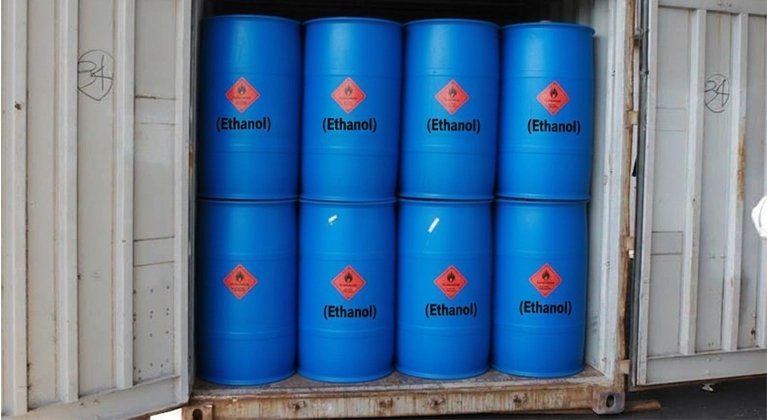Ethanol Supplier | Ethyl Alcohol (C₂H₅OH) Types And Applications

Descriptions of Ethanol
Ethanol (C₂H₅OH), also known as ethyl alcohol, is a clear, colorless, volatile alcohol primarily derived from the fermentation of sugars in crops such as corn, sugarcane, or biomass. It is a renewable, bio-based compound that plays a pivotal role in sustainable energy, pharmaceuticals, cosmetics, food, and industrial applications. With increasing global focus on green innovation and carbon footprint reduction, ethanol is a cornerstone of the modern bioeconomy and clean energy solutions.
What Is Ethanol?
Ethanol can be produced naturally through fermentation or synthetically via petrochemical methods. Its chemical structure and properties make it highly versatile:
-
Fermentation-Derived Ethanol (Bioethanol): Yeast converts sugars from crops into ethanol and carbon dioxide. This bioethanol is widely used in biofuels, beverages, and pharmaceutical products.
-
Synthetic Ethanol: Produced from ethylene via acid-catalyzed hydration, offering high-purity ethanol suitable for industrial, laboratory, and electronic applications.
Ethanol is a renewable alternative to fossil fuels and a key component in biofuels, disinfectants, pharmaceuticals, cosmetics, and food processing.
Types of Ethanol
There are several grades of ethanol designed for specific applications:
-
Industrial-Grade Ethanol: Typically 95% ethanol with 5% water, often denatured. Used in paints, coatings, adhesives, and biofuel fireplaces.
-
Pharmaceutical-Grade (USP) Ethanol: ≥99.5% purity, triple-distilled or refined with molecular sieves. Applied in hand sanitizers, drug formulations, vaccines, and antiseptics.
-
Food-Grade Ethanol: ≥95% purity, free of contaminants. Used in alcoholic beverages, flavor extracts, and food preservatives.
-
Fuel-Grade Ethanol: 99.3–99.5% anhydrous ethanol for biofuels such as E10 and E85, helping reduce emissions.
-
Laboratory-Grade Ethanol: Purity ranges from 70–99.9%. Used in DNA extraction, sterilization, and reagent preparation.
-
Synthetic Ethanol: Derived from petrochemical ethylene; used in electronics, fine chemicals, and precision manufacturing.
-
Bioethanol: Produced from renewable biomass like corn, sugarcane, or agricultural waste. Used as clean fuel and in sustainable chemical production.
Applications and Uses of Ethanol
Ethanol is one of the most versatile industrial chemicals, serving a wide range of sectors:
-
Energy Sector: Ethanol is blended with gasoline (E10, E85) to reduce greenhouse gas emissions and improve engine performance. Bioethanol from agricultural waste supports renewable energy initiatives and promotes circular economy practices.
-
Healthcare & Pharmaceuticals: Used extensively in hand sanitizers, disinfectants, antiseptics, vaccines, and drug formulations due to its antimicrobial and solvent properties.
-
Food & Beverage Industry: Acts as a key ingredient in alcoholic beverages, flavorings, and food preservatives, ensuring safety and consistency in production.
-
Cosmetics & Personal Care: Serves as a solvent, carrier, and preservative in perfumes, hair sprays, lotions, and skincare products. Provides texture, stability, and enhanced shelf life.
-
Industrial Manufacturing: Ethanol is a solvent in paints, coatings, inks, adhesives, and cleaning agents. It enhances product performance and facilitates chemical reactions in production.
-
Scientific & Laboratory Applications: Applied in DNA extraction, sterilization, reagent preparation, and analytical testing. High-purity ethanol ensures accuracy and reliability in research.
-
Sustainable Technologies: Bioethanol is increasingly used in green chemical production, eco-friendly solvents, and bio-based materials, reducing reliance on fossil-derived chemicals.
Ethanol’s broad range of applications demonstrates its importance as a critical industrial and consumer chemical.
Difference Between Methanol and Ethanol
While ethanol and methanol are both alcohols, they differ significantly:
-
Source: Ethanol is produced from fermentation or petrochemical synthesis, whereas methanol comes from natural gas, wood, or petrochemical processes.
-
Toxicity: Ethanol is relatively safe in regulated doses (such as in beverages), but methanol is highly toxic; ingestion can cause blindness or death.
-
Uses: Ethanol is widely used in biofuels, pharmaceuticals, cosmetics, food, and industrial solvents. Methanol is mainly industrial, serving as a solvent, antifreeze, fuel, or chemical feedstock.
-
Boiling Point: Ethanol boils at 78.37°C, while methanol boils at 64.7°C.
-
Safety: Ethanol is flammable but generally safe in controlled applications; methanol requires strict handling due to its toxicity and flammability.
In summary, ethanol is safer and suitable for human consumption and food applications, whereas methanol is strictly industrial.
Advantages of Ethanol
-
Renewable Resource: Ethanol is derived from biomass, reducing dependency on fossil fuels.
-
Eco-Friendly: Helps lower greenhouse gas emissions and environmental impact.
-
Economic Benefits: Supports agriculture and rural economies worldwide.
-
Antimicrobial Properties: Effective in disinfectants and sanitizers.
-
Versatile Solvent: Enhances performance in industrial and consumer products.
Handling and Storage
-
Store ethanol in a cool, dry, and well-ventilated area, away from heat, sparks, or open flames.
-
Keep containers tightly sealed to prevent contamination and evaporation.
-
Use appropriate personal protective equipment (PPE) when handling large volumes.
-
Avoid contact with strong oxidizers and incompatible chemicals.
Packaging and Container Loading
-
Bulk Transport: Ethanol is typically stored in stainless steel ISO tanks, IBC containers, or HDPE/metal drums.
-
Laboratory & Pharmaceutical Use: Sealed glass or plastic bottles with certified purity.
-
Container Loading: Drums and IBCs must be properly secured to prevent movement during transit. Maximum stacking limits should be followed, and containers should be ventilated and kept away from heat sources.
-
Labeling: Packaging adheres to GHS, OSHA, and international safety standards.
Ethanol and Sustainability
Ethanol contributes to global sustainability by providing a renewable, low-carbon alternative to fossil fuels. Advanced production methods, including cellulosic ethanol from agricultural residues and algae-based ethanol, help minimize competition with food crops while reducing environmental impact.

